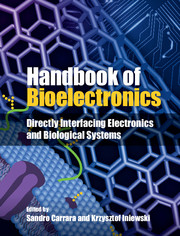Book contents
- Frontmatter
- Contents
- List of Contributors
- 1 What is bioelectronics?
- Part I Electronic components
- Part II Biosensors
- Part III Fuel cells
- Part IV Biomimetic systems
- Part V Bionics
- 22 Introduction to bionics
- 23 Bioelectronic interfaces for artificially driven human movements
- 24 The Bionic Eye: a review of multielectrode arrays
- 25 CMOS technologies for retinal prosthesis
- 26 Photovoltaic retinal prosthesis for restoring sight to the blind
- Part VI Brain interfaces
- Part VII Lab-on-a-chip
- Part VIII Future perspectives
- Index
- References
22 - Introduction to bionics
from Part V - Bionics
Published online by Cambridge University Press: 05 September 2015
- Frontmatter
- Contents
- List of Contributors
- 1 What is bioelectronics?
- Part I Electronic components
- Part II Biosensors
- Part III Fuel cells
- Part IV Biomimetic systems
- Part V Bionics
- 22 Introduction to bionics
- 23 Bioelectronic interfaces for artificially driven human movements
- 24 The Bionic Eye: a review of multielectrode arrays
- 25 CMOS technologies for retinal prosthesis
- 26 Photovoltaic retinal prosthesis for restoring sight to the blind
- Part VI Brain interfaces
- Part VII Lab-on-a-chip
- Part VIII Future perspectives
- Index
- References
Summary
Older readers of this chapter might remember the American TV series “The Bionic Woman”, aired in the late 1970s by NBC and ABC. The main character is nearly killed in a sky-diving accident only to be rescued and receive various surgical implants. As the result of the implanted bionics, she receives amplified hearing in her right ear, a greatly strengthened right arm, and stronger and enhanced legs that enable her to run at speeds exceeding 100 kilometers per hour. Who would not want to have super-human capabilities like these?
Forty years later, bionics has still not delivered on this promise, but at the same time the technological achievements have been amazing. Most of us have watched Oscar Pistorius as the first double leg amputee to participate in the summer Olympics in 2012. He nearly won a medal. Some able-bodied athletes are now arguing that prostheses should be banned in regular competition as it offers unfair advantage.
Prosthetic legs are the simplest example, as they are “merely” a mechanical product. Much more complex devices with sophisticated electronics and signal processing have been developed to restore vision and contact brain tissue directly. One can envision that one day it will be possible to implant many bionic devices to restore, control or enhance many bodily functions, even providing direct connection to medical services through our personal communication systems (Figure 22.1); see [1] for some examples.
- Type
- Chapter
- Information
- Handbook of BioelectronicsDirectly Interfacing Electronics and Biological Systems, pp. 277 - 280Publisher: Cambridge University PressPrint publication year: 2015



